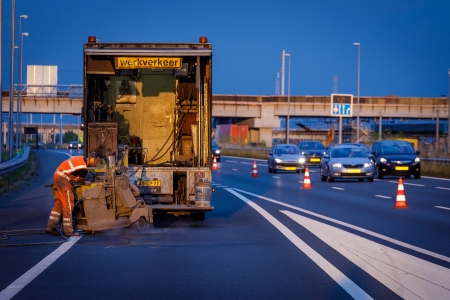There are guidelines and standards to indicate roadworks with maximum clarity and safety (see below). Unfortunately, they are not always complied with. Compliance may improve by also making road safety audits (RSA) and road safety inspections (RSI) mandatory for roadworks. To realise speed reductions at a roadwork location, temporary average speed control or cameras could be an option, particularly for roads outside the urban areas. Within the urban area, lower speeds could be enforced by temporary speed humps or chicanes.
PIARC, the World Road Association, lists four safety principles that all roadwork projects should comply with (the so-called four Cs: Conspicious, Clear, Consistent and Credible) [27]:
- CONSPICUOUS implies that road users should see and recognise the work-in-progress situation and ‘automatically’ adapt their behaviour.
- CLEAR implies that all traffic signs, markings and measures should clearly indicate what is expected of the road user.
- CONSISTENT implies that roadworks should be carried out in a consistent and standardised way. There should not be any or hardly any deviations at locations with similar roadworks.
- CREDIBLE implies that communication with and the message to the road user should be credible to trigger adequate behaviour
Several CROW guidelines describe the principles and requirements for roadworks on motorways and rural roads [28] [29] and the measures needed [30] [31] to reduce crash risk for both road workers and road users (for an example, see Figure 4). A basic principle is a reduction of the maximum speed. For short-term roadworks (such as mowing of the verge or applying new markings), vehicle-mounted arrow boards and crash attenuators are used, or cones and yellow traffic signs. On motorways, lanes are crossed off and speed limits are reduced. Long-term roadworks require more substantial measures, such as temporary markings, securing the construction zone with traffic signs and with concrete and/or other temporary barriers. On motorways, measures vary from local road narrowing, a by-pass or lane closure (with a by-pass by means of the parallel carriageway). On rural single carriageway roads, a one-way system is applied and traffic is managed by on-site traffic controllers or traffic lights.
Recent research shows that there is room for improvement in quality control during planning and implementation of roadwork projects [32]. Previous Dutch research confirms that many roadwork projects fail where compliance with guidelines and standards is concerned [33].

Figure 4. Example of a correct road block for work in progress on motorways, short-term on locations with signalling: On the emergency lane, beyond 1.10 m from the edge marking [30].
